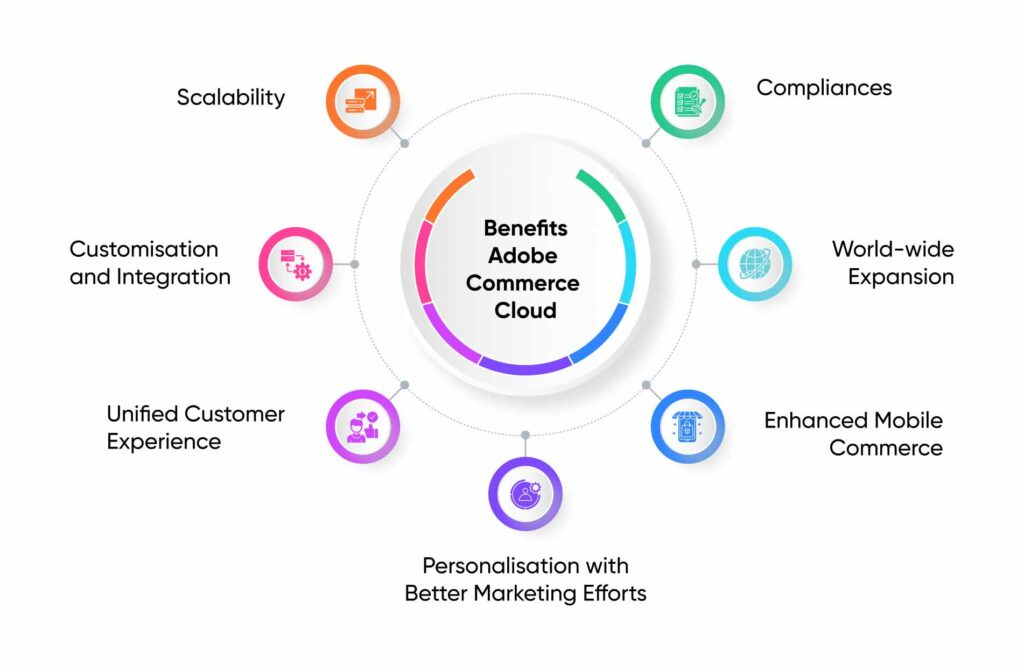
Adobe Commerce Cloud Migration: The Ultimate Guide
Surviving and thriving in the competitive eCommerce industry depends on businesses adapting to innovations and implementing emerging technologies. The eCommerce ecosystem is constantly evolving, driven by changes in consumer behaviour, technological advancements, and the dynamics of the global market. To stay ahead, businesses are focusing on migrating to platforms that can offer better visibility to businesses. For being an innovative option, Adobe commerce migration is the top choice for a number of businesses.
Scaling with flexibility is crucial for every eCommerce business over time. Enter Adobe Commerce Cloud, now emerging as a strategic weapon for eCommerce businesses grappling with the complexities of scaling up and more. Adobe Commerce Cloud offers a full suite of features that empower today’s eCommerce businesses to tackle the challenges of modern times.
Migration to Adobe Commerce Cloud: A Brief
Adobe Commerce Cloud is an innovative cloud-based eCommerce platform that combines flexibility, scalability, and a wide array of features to cater to the diverse needs of businesses. This platform provides merchants with a seamless and integrated experience, allowing them to manage product catalogues, process transactions, and engage customers across multiple touchpoints.
At its core, Adobe Commerce Cloud is a cloud-powered eCommerce platform designed to develop digital commerce applications for web and mobile platforms, offering a flexible and scalable architecture. It provides businesses with features that can be tailored to meet the evolving needs of their end-users and the market.
One of the key strengths of Adobe Commerce Cloud is its integration capabilities, which enable eCommerce business owners to perform critical tasks with ease. Adobe Commerce Cloud offers tailored solutions to meet your specific requirements. The Adobe commerce migration services help to manage extensive product catalogues along with engaging with customers in real-time and managing inventory.
What Benefits Adobe Commerce Cloud Offers?
A well-planned migration from legacy systems to Adobe Commerce Cloud can propel your online retail business into the next phase of digital commerce excellence. Therefore, by leveraging Adobe Commerce Cloud development services, eCommerce businesses can unlock the key to success by delivering seamless customer experiences, streamlining complex operations, and hence crafting a future-ready strategy that is both achievable and sustainable. Adobe Commerce helps to navigate successfully the complexity of modern businesses. Here are more benefits that come along:
-
Scalability
Adobe Commerce Cloud is designed to scale your eCommerce business over time, empowering you to expand seamlessly and flexibly as your customer base and product range grow. This platform enables hassle-free growth, ensuring your business can adapt and thrive in an ever-changing market.
-
Customisation and Integration
Adobe Commerce Cloud offers rich customization features that enable business owners to develop eCommerce apps tailored to their specific needs. The platform facilitates easy third-party integrations, enhancing system extensibility and applicability, allowing businesses to expand their capabilities effortlessly.
-
Unified Customer Experience
Adobe Commerce Cloud development enables seamless integration of your online eCommerce stores and marketplaces with your offline physical stores. This unified approach ensures a consistent and cohesive branding experience, allowing you to deliver a harmonious customer journey across all touchpoints.
-
Personalisation with Better Marketing Efforts
You can integrate and leverage AI-powered recommendations to enhance targeted marketing, campaigns, and promotions, delivering personalized shopping experiences. This advanced technology allows you to tailor your offerings to individual customer preferences, increasing engagement and satisfaction.
-
Enhanced Mobile Commerce
Services from Adobe solutions partner can provide you with a mobile-friendly and responsive eCommerce application. Additionally, you can build a Progressive Web App (PWA) for a faster, more engaging shopping experience, ensuring your customers enjoy seamless and efficient interactions across all devices.
-
World-wide Expansion
Leverage the platform’s support for multiple languages, currencies, and tax structures to cater to a global audience. With advanced localization features, you can effectively operate your store in diverse markets around the world, ensuring a seamless and customized shopping experience for customers everywhere.
-
Compliances
With Adobe Commerce Cloud, you can rest assured that your customer, financial, and business data is protected with maximum security measures. All eCommerce solutions built through Adobe Commerce Cloud comply with standard regulations and security protocols, ensuring a secure working environment for e-store owners and customers alike.
Adobe Commerce Cloud Migration Guide: Explained
Here is the step-by-step guide that explains Commerce Cloud Migration
Step-1: Pre-Migration Planning
-
Business Analysis
Begin by conducting a thorough analysis of your current e-commerce infrastructure, identifying its strengths, weaknesses, and specific pain points. This analysis will help you understand the areas that need improvement and guide your migration strategy. Next, define clear business objectives and goals for migrating to Adobe Commerce Cloud. These objectives should certainly align with your overall business strategy and focus on improving customer experience, increasing operational efficiency, and driving revenue growth
-
Stakeholder Alignment
To ensure a successful migration to Adobe Commerce Cloud, it’s crucial to align key stakeholders within your organization regarding the goals and expected outcomes of the migration. This alignment ensures that everyone is on the same page and working towards a common goal. Additionally, establish a cross-functional team responsible for overseeing and executing the migration process. This team should include members from various departments, such as IT, marketing, and sales, to ensure that all aspects of the migration are considered and executed effectively.
-
Infrastructure Evaluation
Start by evaluating your current technology stack, encompassing databases, servers, and third-party integrations. Identify potential compatibility issues with Adobe Commerce Cloud and strategize for required updates or modifications. This proactive approach ensures a seamless migration, minimizing disruptions and maximizing the benefits of the new platform.
Step 2: Data Migration
-
Data Inventory
Develop a detailed inventory of all data pertinent to your e-commerce operations, encompassing product catalogues, customer information, and order history. Categorize this data based on its importance and relevance to your business, ensuring that critical information is prioritized for a smooth transition to Adobe Commerce Cloud.
-
Data Cleansing
Before migrating to Adobe Commerce Cloud, it’s essential to cleanse and optimize your data to ensure accuracy and consistency. Correspondly, identify and resolve any duplicate or outdated records that could impede the migration process. This step is crucial for a successful transition, as it ensures that your data is clean and ready for migration to the new platform.
-
Data Mapping
Thoroughly map the source and destination data structures to ensure a seamless transition of information during migration to Adobe Commerce Cloud. Define clear relationships between different data sets to maintain data integrity throughout the process. This meticulous mapping is crucial for ensuring that all relevant data is accurately transferred and properly integrated into the new platform.
Step 3: Customisation and Integration
-
Platform Customisation
Utilize the flexibility of Adobe Commerce Cloud to customize the platform to meet your specific business needs. Tailor themes, layouts, and functionalities to align with your brand identity and user experience goals. This customization allows you to create a unique and engaging online store that resonates with your target audience.
-
Third-party Integration
Identify the third-party applications, payment gateways, and ERP systems that are essential for your e-commerce operations. Integrate these systems with Adobe Commerce Cloud, ensuring compatibility and smooth communication between all integrated solutions. This integration streamlines your business processes, enhances customer experience, and maximizes the capabilities of your e-commerce platform.
Step 4: User Training and Adoption
-
Training Program
Create comprehensive training programs to familiarize your team with the features and functionalities of Adobe Commerce Cloud. These programs from any Adobe Commerce company should include training sessions for administrators, developers, and end-users to ensure that everyone is proficient in using the platform. This training will empower your team to make the most of Adobe Commerce Cloud, enhancing productivity and driving success for your e-commerce business.
-
Change Management
Implementing a change management strategy is crucial to easing the transition for your team. Communicate the benefits and efficiencies gained through the migration to Adobe Commerce Cloud to ensure everyone understands the value of the change. This proactive approach will help alleviate any concerns and resistance, paving the way for a smoother and more successful transition process.
Step 5: Quality Assurance
-
Test Environment
Establish staging environments that replicate the production environment for testing purposes when migrating to Adobe Commerce Cloud. Conduct comprehensive testing of data migration, functionality, and performance in these environments to ensure a smooth transition. Therefore, this step is critical for identifying and resolving any issues before deploying changes to the live environment. Additionally, minimizing disruptions to your e-commerce operations.
-
Quality Assurance
Implementing a robust quality assurance process is essential when migrating to Adobe Commerce Cloud. Moreover, this process helps identify and address any issues promptly, ensuring a smooth transition. Perform regression testing to ensure that existing functionalities remain intact throughout the migration process. This meticulous approach guarantees a seamless user experience and minimizes the risk of disruptions to your e-commerce operations.
Step 6: Post Migration Optimisation
-
Monitoring and Analysis
Continuously monitoring the performance of your Adobe Commerce Cloud implementation is crucial for maintaining a high-quality user experience. Utilize analytics tools to gain insights into customer behaviour, website performance, and the effectiveness of your marketing campaigns. This data-driven approach allows you to make informed decisions and optimize your e-commerce operations for maximum success.
-
Continuous Improvements
Iterating and optimizing based on data-driven insights is key to continuously improving your Adobe Commerce Cloud implementation. Similarly, solicit feedback from users and stakeholders will help to identify areas for improvement and prioritize enhancements. As a result, this iterative approach ensures that your e-commerce platform remains aligned with evolving customer needs. Also ensure market trends are fulfilled, driving ongoing success for your business.
The Bottom Line
In conclusion, migrating to Adobe Commerce Cloud is a transformative journey that also requires careful planning, execution, and ongoing optimization. Additionally, by following the steps outlined in this guide, you can ensure a seamless transition. Simultaneously, this will maximize the benefits of this powerful e-commerce platform. Also, from assessing your current infrastructure to implementing robust testing and monitoring processes, every step plays a crucial role in the success of your migration. Therefore, with the right approach, Adobe Commerce Cloud can unlock new opportunities for growth, innovation, and customer engagement. Additionally, this will position your business for long-term success in the dynamic world of e-commerce.
